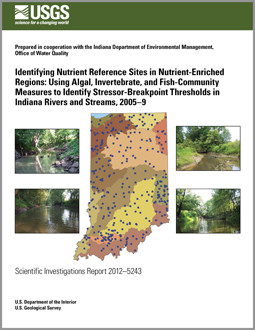

IDENTIFYING NUTRIENT, INDIANA RIVERS, IN
Product Details
- Product Number
- 360827
- Series
- SIR-2012-5243
- Scale
- NO SCALE
- Alternate ID
- SIR-2012-5243
- ISBN
- 978-1-4113-3539-4
- Authors
- AUBREY R BUNCH
- Version Date
- 01/01/2012
- Regions
- IN
- Countries
- USA
- Media
- Paper
- Format
- Bound
Additional Details
- Description
-
Abstract
Excess nutrients in aquatic ecosystems can lead to shifts in species composition, reduced dissolved oxygen concentrations, fish kills, and toxic algal blooms. In this study, nutrients, periphyton chlorophyll a (CHLa), and invertebrate- and fishcommunity data collected during 2005–9 were analyzed from 318 sites on Indiana rivers and streams. The objective of this study was to determine which invertebrate and fish-taxa attributes best reflect the conditions of streams in Indiana along a gradient of nutrient concentrations by (1) determining statistically and ecologically significant relations among the stressor (total nitrogen, total phosphorus, and periphyton CHLa) and response (invertebrate and fish community) variables; and (2) determining the levels at which invertebrate- and fish-community measures change in response to nutrients or periphyton CHLa.
For water samples at the headwater sites, total nitrogen (TN) concentrations ranged from 0.343 to 21.6 milligrams per liter (mg/L) (median 2.12 mg/L), total phosphorus (TP) concentrations ranged from 0.050 to 1.44 mg/L (median 0.093 mg/L), and periphyton CHLa ranged from 0.947 to 629 mg/L (median 69.7 mg/L). At the wadable sites, TN concentrations ranged from 0.340 to 10.0 mg/L (median 2.31 mg/L), TP concentrations ranged from 0.050 to 1.24 mg/L (median 0.110 mg/L), and periphyton CHLa ranged from 0.383 to 719 mg/L (median 44.7 mg/L).
Recursive partitioning identified statistically significant low and high breakpoint thresholds on invertebrate and fish measures, which demonstrated the ecological response in enriched conditions. The combined community (invertebrate and fish) mean low and high TN breakpoint thresholds were 1.03 and 2.61 mg/L, respectively. The mean low and high breakpoint thresholds for TP were 0.083 and 0.144 mg/L, respectively. The mean low and high breakpoint thresholds for periphyton CHLa were 20.9 and 98.6 milligrams per square meter (mg/m2), respectively. Additive quantile regression analysis found similar thresholds (TN of 0.656 mg/L, mean TP of 0.118 mg/L, and periphyton CHLa of 27.2 mg/m2) for some stressor variables as determined by the breakpoint analysis.
The TN and TP concentrations in this study showed a nutrient gradient that spanned three orders of magnitude. Sites were divided into Low, Medium, and High nutrient groups based on the 10th and 75th percentiles. The invertebrate and fish communities were similar along the nutrient gradient, using an analysis of similarity, demonstrating there was not a species trophic gradient. Within all nutrient groups, invertebrate and fish communities were dominated by nutrient tolerant taxa (algivores, herbivores, and omnivores) that included invertebrates, such as Cheumatopsyche sp., Physella sp., and fish such as Stonerollers (Campostoma spp.) and Bluntnose Minnow (Pimephales notatus).
To determine if low nutrient concentrations at some sites were caused by algal uptake and not oligotrophic conditions, sites with low nutrient concentrations (less than 10th percentile for TN or TP) were examined based on the Low (less than or equal to the 10th percentile) and High (greater than the 75th percentile) periphyton CHLa concentrations. Within low nutrient sites, the invertebrate and fish communities were statistically different between Low and High periphyton CHLa categories. The majority of variance between the Low and High periphyton CHLa categories was caused by Cheumatopsyche sp. (caddisfly), Physella sp. (pulmonate snail), and Caenis latipennis (a mayfly) in the invertebrate community; and caused by Stonerollers, Western Blacknose Dace (Rhinichthys atratulus meleagris), and Creek Chub (Semotilus atromaculatus) in the fish community. The dominance of tolerant herbivore and omnivore taxa in the High periphyton CHLa group indicates that low nutrient concentrations are a result of nutrient uptake and increased algal growth. This study highlights the importance of assessing multiple lines of evidence when attempting to identify the trophic condition of a site.
- Height In Inches
- 11.000
- Width In Inches
- 0.125
- Length In Inches
- 8.500
- Two Sided
- Yes
- Pieces
- 2




